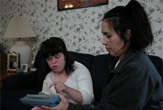Academy Award-nominated Film Promotes False Hopes

The subject of autism is very much in the news. It was a recent cover story in Newsweek, in nightly news shows, and even at the Academy Awards. Autism is a severe developmental disability affecting about four to five out of every ten thousand children, and is characterized by delayed and often abnormal communication and behavior. The disease is heartbreaking, in part because many autistic children look otherwise normal, which can inspire hope that they may just snap out of it one day and start talking and laughing like a normal child.
There were five nominees for the 2004 Academy Award in the category of Documentary Short Subject. One of the films, Gerardine Wurzburg's Autism Is a World, is about a woman named Sue Rubin who was diagnosed with autism at the age of four. Yet, according to the film's press materials, Sue is now "a junior in college with a top IQ, a tireless disability-rights activist, and an articulate guide into a complex disorder."
How did this happen? What turned a person with the mental capacity of a two-year-old into a college student with an IQ of 133? The film suggests that this miraculous transformation occurred through the use of a technique called facilitated communication (FC). Yet the film fails to tell its audience that the technique is not just controversial; it has, in fact, been discredited.
In the 1980s and 1990s, many parents of autistic children (including Rubin's) turned to facilitated communication, which had been claimed to help autistic children (and others who have limited communication abilities) to communicate better. The idea behind FC is based on the premise that the lack of communication is not due to an underlying cognitive disorder, but instead to motor disorders such as those affecting the ability to coordinate speech. What is needed, FC advocates claim, are trained facilitators to help the autistic children by holding their hands, fingers, or elbows while the child types on a keyboard or points to lists of letters, words, or symbols to communicate. In this way, the child can break through the tragic blockage of her disorder and speak, perhaps for the first time, to her parents and loved ones.
This technique was developed in the 1970s by Rosemary Crossley and others at the Dignity Through Education and Language Communications Centre in Melbourne, Australia. It was introduced in the United States by Douglas Biklen, a special education director at Syracuse University (and a co-producer of the film). Anecdotal stories of children who had been silent all their lives but could now form sentences, express their dreams and fears, and even write poetry encouraged many parents to sign up for classes and hire facilitators. They saw the results as a miraculous breakthrough and signed up for FC workshops and sessions costing hundreds of dollars; specialized equipment cost around $800 more.
Yet the celebration was premature. As the technique and phenomenon were studied further, glaring problems became apparent. The premise that communication problems in autistic patients came from speech motor dysfunction was unsupported by medical science. The messages that the autistic children were sending much more closely matched those of the facilitator than the child. The words, diction, nuances, and grammatical structures used in the messages frequently far exceeded what an autistic child could have learned. (This, however, rarely deterred FC proponents, who stubbornly took this troublesome evidence instead as proof that doctors were underestimating the autistic childrens' abilities.)
Frequently the child wasn't even looking at the keyboard or letters, yet continued to type out her messages. Furthermore, when the child was asked questions only the child knew (but the facilitator didn't), the child was unresponsive or gave incorrect answers; similarly, when the facilitator and child were shown two pictures independently, the child responded correctly only when the same pictures were also seen by the facilitator. In short, it was clear that the facilitators were fooling themselves and simply typing out what they thought the child would say.
Get the world’s most fascinating discoveries delivered straight to your inbox.
Numerous studies over two decades have failed to validate the claims of Crossley, Biklen, and others. The American Psychological Association has found no scientific evidence that FC works, and Gina Green, director of research at the New England Center of Autism, likened the technique to "dowsing sticks and the ouija board." No one claims that FC proponents or facilitators maliciously deceived parents of autistic children. Yet money was lost and hopes were raised--then shattered--when hope and emotion jumped ahead of science.
Autism is a World may in fact document a miracle. But science and medical evidence suggest otherwise, and by leaving out information that casts doubt on the technique, this Oscar-nominated film may cruelly foster false hopes in friends and families of autistic children.
Benjamin Radford is managing editor of the science magazine Skeptical Inquirer, and wrote about facilitated communication in his 2003 book Media Mythmakers: How Journalists, Activists, and Advertisers Mislead Us.



